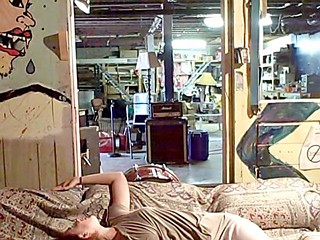Dances Made To Order
Anthropomorphism, upheaval, and memory in dance for the small screen
By Jonelle Seitz, Fri., Nov. 16, 2012

Just 17 days before the premiere of the Austin edition of the online dance-film festival Dances Made To Order, choreographers Ellen Bartel, Kathy Dunn Hamrick, and Katherine Hodges each received an email revealing the two themes that would drive their work: "let me in/let me out" and "beginning to disappear." In a roundabout way, the choreographers' themes were self-directed: They were chosen by visitors to the DMTO site, from a longer list developed by Los Angeles-based founder Kingsley Irons, who extrapolated the ideas from the choreographers' answers to her questions ("Dances Made to Order," Oct. 19). The winning suggestions, posed in unassuming lowercase, are decidedly nondirective and introspective, and smartly so. Rather than simply illustrating how oh-so-different the fibers that bind movement to concept can be, Irons' endeavor leaves the concepts themselves open for interpretation, while giving the artists a thought-provoking jump start for quick-turnaround creation.
For dance on camera, creation means not just choreography, music, and costuming, but also filming and editing two-dimensional footage into a multifaceted work. In this genre, the freshness and spontaneity of live theatre give way to sleek frames in select takes, but this is a loss in exchange for the gifts of the camera: manipulation of the viewer's focus and allowances for impossible moves in space and time. Transitions can all but disappear, while other moments can be unpacked, stretched out, pulled, left out to breathe. And, of course, film offers a novelty many dance artists rarely consider: preservation for posterity.
So, it's not surprising that for all three choreographers, time manipulation and preservation are important considerations. Hamrick has choreographed in Austin for more than a decade but has done little work in film, and for her, posterity isn't something to be scoffed at. In a blog post on the DMTO website, she ponders the pros and cons of creating work that could potentially outlast herself. Her film, however, is a sequel to a concert work that I am in no danger of forgetting: the final two-minute segment of last year's FlashDance, but Flashier: 30 More Dances in 60 Minutes. In that whimsical yet tear-jerking 120 seconds, Hamrick anthropomorphized two cardboard boxes in a failed relationship – believe me, it was more than the sum of its parts. Her DMTO film, Hamrick says, allows her, in collaboration with Kakii Keenan, to do "things with the box that we couldn't do onstage." She wouldn't give away the ending, but I am hoping that in the film, the forlorn box finds fulfillment.
As with much of Hamrick's work for the stage, her approach to the project was practical and lighthearted. For Bartel, the DMTO themes offered an opportunity to continue her exploration of what she has referred to as "transitional spaces," which are defined in space and time. Like her previous work, the transition in her DMTO film is both physical and nonphysical. It takes place in the basement of the home she shares with her husband, who was recently diagnosed with cancer. In the film, the basement, formerly the site of the couple's raucous happy hours, and home to murals, couches, drum sets, guitars, props, and costumes, begins to shoulder the burdens of disorder, uprooting, transition. Working with a group of veteran dancers and her longtime composer/collaborator Adam Sultan, as well as with videographer Eliot Haynes, Bartel physically dismantles the space, via movement of and around the objects within it, in an effort to "break the static" of memory; to move forward.
Memory itself – its fragmented, imperfect self – is the subject of Hodges' film. Over several mornings, early enough to take advantage of the sun's first rays filtering into a mirror-filled space, Hodges and dancer Danielle Casey, who regularly work together on dance-film projects, consider when and how memories are made and reappear: How do we subconsciously choose which ones to allow in, close off, or rewrite? The answer there is complex, so if you take a few minutes out of your daily screen time to view these films, there's no telling which parts of them your mind will commit to memory, and during which of your future moments those memories will present themselves.
Dances Made to Order's Austin edition is available for online viewing at www.dancesmadetoorder.com; a pass to view the three films is $10. Limited free views are also available in exchange for response to a survey.











